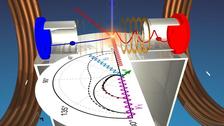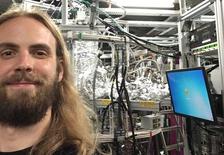Artist view of the process and cross section for Compton scattering (front) and the COLTRIMS reaction microscope which enabled the experiment (back). Photons (wiggly line) hit an electron in the atom in the centre of the COLTRIMS reaction microscope knocking out an electron (red ball) and leaving an ion (blue ball) behind. Both particles are guided by electric and magnetic fields toward detectors (red and blue discs.) (Credit: Goethe University Frankfurt [Source])
Light can be used to knock electrons out of atoms, with light particles and electrons bouncing off each other like two billiard balls – Compton scattering. Why electrons can even be ejected from an atom when the light does not actually have enough energy to do so has now been discovered by a team of physicists headed by researchers from Goethe University Frankfurt, using X-ray measurements at DESY. The team reports the results in the journal Nature Physics.
When the American physicist Arthur Compton discovered that light waves behave like particles in 1922, and could knock electrons out of atoms during an impact experiment, it was a milestone for quantum mechanics. Five years later, Compton received the Nobel Prize for this discovery. Compton used very shortwave light with high energy for his experiment, which enabled him to neglect the binding energy of the electron to the atomic nucleus. Compton simply assumed for his calculations that the electron rested freely in space.
During the following 90 years up to the present, numerous experiments and calculations have been carried out with regard to Compton scattering that continually revealed asymmetries and posed riddles. For example, it was observed that in certain experiments energy seemed to be lost when the motion energy of the electrons and light particles (photons) after the collision were compared with the energy of the photons before the collision. Since energy cannot simply disappear, it was assumed that in these cases, contrary to Compton’s simplified assumption, the influence of the nucleus on the photon-electron collision could not be neglected.
For the first time in an impact experiment with photons, a team of physicists led by Professor Reinhard Dörner and doctoral candidate Max Kircher at Goethe University Frankfurt have now simultaneously observed the ejected electrons and the motion of the nucleus. To do so, they irradiated helium atoms with X-rays from DESY's light source. At the PETRA III beamline P04, they detected the ejected electrons and the charged rest of the atom (ions) in a COLTRIMS reaction microscope, an apparatus that Dörner helped develop and which is able to make ultrafast reactive processes in atoms and molecules visible.The results were surprising. First, the scientists observed that the energy of the scattering photons was of course conserved and was partially transferred to a motion of the nucleus (more precisely: the ion). Moreover, they also observed that an electron is sometimes knocked out of the nucleus when the energy of the colliding photon is actually too low to overcome the binding energy of the electron to the nucleus. Overall, the electron was only ejected in the direction one would expect in a billiard impact experiment in two thirds of the cases. In all other instances, the electron is seemingly reflected by the nucleus and sometimes even ejected in the opposite direction.
Reinhard Dörner (Goethe University Frankfurt): “This allowed us to show that the entire system of photon, ejected electron and ion oscillate according to quantum mechanical laws. Our experiments therefore provide a new approach for experimental testing of quantum mechanical theories of Compton scattering, which plays an important role, particularly in astrophysics and X-ray physics.”
Goethe University Frankfurt, the Fritz Haber Institute of the Max Planck Society, Leibniz University Hannover, University Sétif-1 in Algeria, the Joint Institute for Nuclear Research JINR in Dubna (Russia), National University of Mongolia, Lomonosov Moscow State University, Sorbonne Universités in Paris, Uppsala University in Sweden and DESY were involved in this research.
(Source: Goethe-Universität Frankfurt )
Reference:
Kinematically complete experimental study of Compton scattering at helium atoms near the ionization threshold; Max Kircher, Florian Trinter, Sven Grundmann, Isabel Vela-Perez, Simon Brennecke, Nicolas Eicke, Jonas Rist, Sebastian Eckart, Salim Houamer, Ochbadrakh Chuluunbaatar, Yuri V. Popov, Igor P. Volobuev, Kai Bagschik, M. Novella Piancastelli, Manfred Lein, Till Jahnke, Markus S. Schöer, Reinhard Dörner; Nature Physics, 2020; DOI: 10.1038/s41567-020-0880-2








